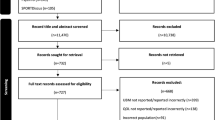Abstract
Purpose: To identify risk factors for a decline in upper body function following treatment for early stage breast cancer.
Methods: We conducted a cross-sectional observational study of 213 women ≥ 55 years of age newly diagnosed with early stage breast cancer interviewed three to five months following their definitive surgery. Patients were classified as having impaired upper body function related to their breast cancer treatment if: 1) they reported having no difficulty in performing any of three tasks requiring upper body function (pushing or pulling large object; lifting objects weighing more than 10 pounds; and reaching or extending arms above shoulder level) prior to treatment, but reported that any of these tasks were somewhat or very difficult in the four weeks prior to interview, or 2) they reported that performing any of the three tasks requiring upper body function was somewhat difficult prior to treatment, but reported that any of these tasks were very difficult in the four weeks prior to interview.
Results: In multiple logistic regression models, both the extent and type of primary tumor therapy and cardiopulmonary comorbidity were significantly associated with a decline in upper body function following breast cancer treatment.
Conclusion: Given the critical importance of upper body function in maintaining independent living, clinicians should consider the functional consequences of treatment when they discuss treatment options and post-operative care with older women who have early stage breast cancer.
Similar content being viewed by others
References
Silliman RA, Balducci L, Goodwin JS, Holmes FF, Leventhal EE: Breast cancer care in old age: What we know, don't know, and do. J Natl Cancer Inst 85: 190–199, 1993
Chu KC, Tarone RE, Kessler LG, Ries LAG, Hankey BF, Miller BA, Edwards BK: Recent trends in U.S. breast cancer incidence, survival, and mortality rates. J Natl Cancer Inst 88: 1571–1591, 1996
Satariano WA, Ragheb NE, Branch LG, Swanson GM: Difficulties in physical functioning reported by middleaged and elderly women with breast cancer: a case-control comparison. J Gerontol: Med Sci 34: M3–M11, 1990
Satariano WA, Ragland DR, DeLorenze GN: Limitations in upper-body strength associated with breast cancer: a comparison of black and white women. J Clin Epidemiol 49: 535–544, 1996
Silliman RA, Troyan SL, Guadagnoli E, Kaplan SH, Greenfield S: The impact of age, marital status, and physicianpatient interactions on the care of older women with breast cancer. Cancer 80: 1326–1334, 1997
Jette AM, Branch LG: The Framingham disability study: II. Physical disability among the aging. Am J Public Health 71: 1211–1216, 1981
Nagi SZ: An epidemiology of disability among adults in the United States. Milbank Mem Fund Q 54: 439–468, 1976
Greenfield S, Sullivan L, Dukes KA, Silliman R, D'Agostino R, Kaplan SH: Development and testing of a new measure of case mix for use in office practice. Med Care 33: AS47–AS55, 1995
Sneeuw KCA, Aaronson NK, Yarnold JR, Broderick M, Regan J, Ross G, Goddard A: Cosmetic and functional outcomes of breast conserving treatment for early stage breast cancer: 1. Comparison of patients' ratings, observers' ratings and objective assessments. Rad Onc 25: 153–159, 1992
Gerber L, Lampert M, Wood C, Duncan M, D'Angelo T, Schain W, McDonald H, Danforth D, Findlay P, Glatstein E, Lippman ME, Steinberg SM, Gorrell C, Lichter A, Demoss E: Comparison of pain, motion, and edema after modified radical mastectomy vs. local excision with axillary dissection and radiation. Breast Cancer Res Treat 21: 139–145, 1992
Albertini JJ, Lyman GH, Cox C, Yeatman T, Balducci L, Ku NN, Shivers S, Berman C, Wells K, Rapaport D, Shons A, Horton J, Greenberg H, Nicosia S, Clark R, Cantor A, Reintgen DS: Lymphatic mapping and sentinel node biopsy in the patient with breast cancer. JAMA 276: 1818–1822, 1996
Goodwin JS, Samet JM, Hunt WC:Determinants of survival in older cancer patients. J Natl Cancer Inst 88: 1030–1038, 1996
Hughes SL, Gibbs J, Dunlop D, Singer R: Predictors of hand function in older persons: A two-year longitudinal analysis. J Am Geriatr Soc 43: 122–129, 1995
Author information
Authors and Affiliations
Rights and permissions
About this article
Cite this article
Silliman, R.A., Prout, M.N., Field, T. et al. Risk factors for a decline in upper body function following treatment for early stage breast cancer. Breast Cancer Res Treat 54, 25–30 (1999). https://doi.org/10.1023/A:1006159720583
Issue Date:
DOI: https://doi.org/10.1023/A:1006159720583




